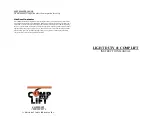
Rev 26.0/6-13
6
P1-DC: #35111
ASSEMBLY
1) Open the shipping container and remove all materials for restraining or protecting the vacuum
lifter. Save the container for use whenever the lifter is transported.
2) Suspend the lifter from a crane as follows: Select hoisting equipment (crane and hoist, when
applicable) rated to carry the maximum load weight plus the lifter weight (see
SPECIFICATIONS: Maximum Load Capacity and Lifter Weight).
Note: Any application of the lifter must conform to all statutory or regulatory standards that
relate to the hoisting equipment when used in its geographical location (eg, relevant OSHA
standards in the USA).
Disengage the tilt latch (see OPERATION: T
O
T
ILT THE
L
OAD
) and raise the lift bar to a vertical
orientation. Then attach the hoisting equipment hook to the lift bail.
WARNING: Hoisting equipment hook must be fitted with restraining latch to
prevent lift bail from slipping off under any circumstances.
Note: Some hoisting equipment hooks could interfere with an upright load that extends
beyond the lifter's pad channel. If the load would contact the hook during lifter operation,
the operator must prevent this by attaching a sling (or other rigging that does not interfere
with the load) between the hook and the lift bail.
WARNING: Any sling used must be rated to carry maximum load weight plus
lifter weight.
Use the hoisting equipment to raise the lifter out of the shipping container. Be careful to
avoid damaging any vacuum pads. Remove the pad covers and save them for use whenever
the lifter is stored.
3) Connect the electrical connectors uniting the battery to the battery charger and the vacuum
generating system. The lifter is now operational.
4) Perform Operational and Load Tests for the lifter as directed in MAINTENANCE: T
ESTING
S
CHEDULE
.
Summary of Contents for P11004DC
Page 2: ......
Page 32: ...Rev 26 0 6 13 30 P1 DC 35111 ...
Page 33: ...Rev 26 0 6 13 31 P1 DC 35111 ...
Page 34: ...Rev 26 0 6 13 32 P1 DC 35111 ...









































